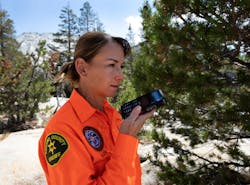AT&T and FirstNet often go hand-in-hand in conversations regarding public safety communications. Where AT&T makes the call connect, FirstNet makes sure it is working as first responders need it to be. Scott Agnew AT&T Assistant Vice President for FirstNet Products explains: “FirstNet Authority is responsible for the implementation, oversight of the contract that they have set forth and appropriately ensure the oversight that is set in contractual terms that the terms are being met for public safety. AT&T is the vendor that was chosen. We’re responsible for implementing the network, managing, deploying, and life-cycling the users.”
To put it simply, there is a reason for the moniker “FirstNet built with AT&T.” AT&T’s technology applied to the FirstNet project is a dedicated network and dedicated core to—and exclusively for—first responders. Any commercial/consumer network falls under a separate core as AT&T’s Wireless Network.
Officers will need a FirstNet SIM card for their device to connect to the network. These are black, include “FirstNet” printed on the card, and your screen will report “FirstNet” as a network identifier (in place of 3G, or 4G). The difference between the consumer experience on a network versus a first responder’s is priority and preemption. “On FirstNet,” says Agnew, “it is very simple: make the phone call, you are identified as a priority user you are traversing through the network that is prioritized. Once connected that priority continues throughout that voice call or that data call.”
If you’ve ever been at an event like a football game and failed to send that text message back home, it’s likely because everyone else was too. In laymen’s terms, the network was busy, with too many people attempting to utilize one pipe of the network. FirstNet is an entirely different pipe.
In one of the preparations for the worst possible scenario, AT&T has available a fleet of deployable units to either add to or compensate any network coverage available throughout the country, set in undisclosed strategic locations to be able to respond to first responder’s needs up to 14 hours (often sooner)—chances are one is already in your area. Situations such as a search and rescue where there would be no coverage, natural disasters, a power outage, or even planned events like the response of the U.S.N.S. Comfort, or a Super Bowl, are options to support communications. For example, AT&T received 22 public safety requests in the first month of COVID-19.
“Public safety primary users can request, at any time, those deployables,” adds Agnew. “It costs them nothing and we evaluate each request. We have hundreds of people in AT&T that support this. They are on standby ready to go.” He works with the FirstNet Response Operations Group—a dedicated group of individuals to work with public safety, plan, and collaborate with public safety well in advance to ensure everyone involved has the tools and devices needed. “I think that is one of the most important things FirstNet does,” he says. “It’s not just about the network, it’s about how we operationalize and support public safety.”
This support doesn’t end there. AT&T’s online portal FirstNet Central makes available several tools to help manage and control their operational status and site conditions. (FirstNetCentral changed its name from FirstNet Local Control as of April 20, 2020.) One such tool, the “Network Status Tool,” provides near real-time performance on the status of the network. If there is a tower out due to maintenance or trouble ticket, that is all communicated to public safety without a call to a corporate call center informing of loss of coverage. Since knowledge is key, the tool was designed to provide the information up-front for law enforcement to better prepare.
FirstNet Central also provides primary users to “uplift” groups to a higher priority level within the FirstNet network. FirstNet organizes entities like law enforcement, fire, EMS, PSAPs, etc., as “primary agencies”—the core users the network was designed for. However, public safety doesn’t end there. Additional organizations such as the transportation department or utilities that may be involved for support are considered “extended primary users.” Where both have priority, extended users don’t have preemption. While unlikely, should the network be busy, communications from extended will be preempted if bandwidth is needed for primary agencies. If the extended agency is critical to the event, a primary agency can uplift them to the higher priority using the FirstNet Central portal. (The support organization also has the ability to request uplift as well.)
Additional data layers available on FirstNet Central to primary agency subscribers include weather, geography, topography, wind conditions, and even COVID data.
New developments
Just late March 2020, AT&T launched a land mobile radio (LMR) interoperability solution in the FirstNet Push-To-Talk (PTT) application, based on 3GPP Standards for mission critical communications. This app allows officers to utilize PTT communications from their FirstNet-enabled devices to users with radio legacy technology. “This means that it uses technology that uses higher priority values that ensures higher reliability, higher retainability, and lower latency” explains Agnew. First responders can utilize radio-over-IP hardware-based technology that agencies can implement to connect to FirstNet network with the analog LMR network.
There are more innovations to come. “There are 11 mission critical core standards that we have to deploy; PTT is the first one. There’s proximity services, there’s mission critical data—that’s all on the roadmap,” says Agnew. The goal is to have all mission critical services deployed by the end of AT&T’s final operating commitment with FirstNet (which has a deadline of 2023). However, he says they’re already 80 percent there.
Other solutions and more information on the FirstNet marketplace can be found on the FirstNet Central portal, through FirstNet.com, as well as visiting a physical AT&T store.
Advancement is always on the horizon. “What is already great, is just going to get better and better,” says Agnew.
About the Author

Jonathan Kozlowski
Jonathan Kozlowski was with Officer.com, Law Enforcement Technology, and Law Enforcement Product News from August 2006 to 2020.
As former Managing Editor for Officer Media Group, he brought a dedicated focus to the production of the print publications and management of the Officer.com online product and company directory. You can connect with Jonathan through LinkedIn.
Jonathan participated as a judge for the 2019 and 2020 FOLIO: Eddie & Ozzie Awards. In 2012, he received an APEX Award of Excellence in the Technology & Science Writing category for his article on unmanned aerial vehicles (UAVs) in police work, aptly titled "No Runway Needed".


